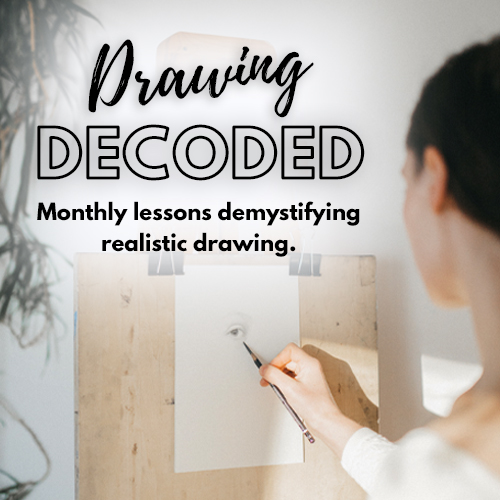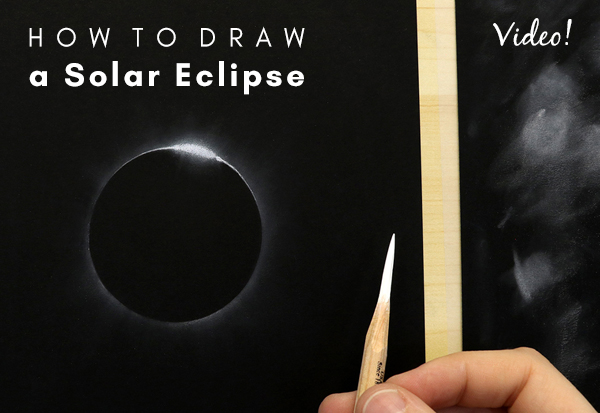- Home
- Drawing Tutorials
- Charcoal Pencil Brands
Recommended Charcoal Pencil Brands
and How to Compare Them
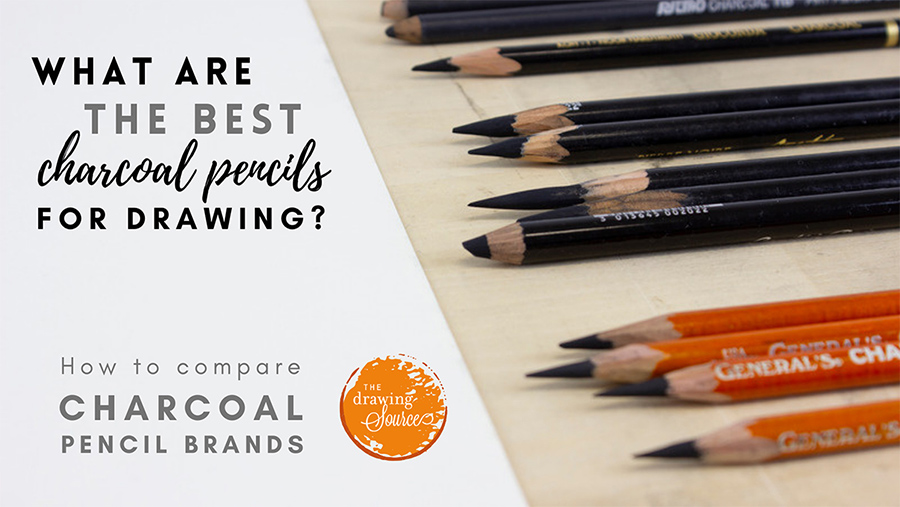
What are the best charcoal pencil brands? With the quantity of drawing pencils available to us, who wouldn’t
want to know?
When it comes to drawing supplies, I tend to find ones that I like and stick with them, often for years! However, with online students all over the world, all of whom have access to different charcoal pencil brands, I started receiving more and more questions about them: whether a brand other than the one I recommend could be used in my course, what the differences are between them, etc. It was high time to start doing some research and comparing more charcoal pencil brands!
While I will certainly tell you what charcoal pencils I have been using for years and recommend, in this article I’ll also describe my process for comparing charcoal pencils brands so that you can find the ones you consider to be the best charcoal pencils for you. Because while one artist may swear by a certain brand of pencil, you’re guaranteed to find another artist who prefers a different one!
After my recommendations, in this article I’ll present the criteria that I consider when comparing charcoal pencil brands, as well as the process that I use, so that you can do the same. I'll also provide a detailed brand comparison, and as I conduct further comparisons of charcoal pencils in the future, I’ll add them here as well. If you’d like for me to compare certain charcoal pencil brands, feel free to contact me, or post in the comments at the bottom of the page!
Recommended Charcoal Pencil Brands
Looking for quick recommendations? Here they are:
General's Charcoal Pencils
These are the charcoal pencils I have been using for years and highly recommend. They meet all of my personal criteria, which you can read about below.
Conte Pierre Noire Pencils
Though these are likely a charcoal composite (compressed charcoal mixed with another substance), the characteristics of these pencils convincingly resemble that of compressed charcoal. The main difference is that these pencils are slightly waxier, which makes them less powdery and less messy than pure charcoal, though also slightly less blendable. Because these pencils are slightly easier to control than pure compressed charcoal pencils, these are excellent pencils for beginners just starting to work with charcoal.
These are certainly more excellent charcoal pencil brands out there. As I conduct further, in-depth comparisons (such as the one you'll find below), I'll add more brands to this list. However, keep reading to discover the essential criteria for good charcoal pencil brands.
Why Draw with Charcoal Pencils?
To determine what to look for in ‘the best charcoal pencils’, let’s first remember why we use charcoal in general. What are the benefits of drawing with charcoal?
Though the answer may differ slightly from artist to artist, I use charcoal primarily to have a full range
of values to work with (meaning from white to pitch black), and I want to be able to create my darkest values without
the metallic shine of graphite. (Read about the differences between graphite
and charcoal, and the pros and cons of each in my drawing pencils guide.) This means that at the very least, the set of charcoal pencils that I select needs to allow me to comfortably create a full value range.
I also love the versatility of charcoal - primarily its ability to be used with white drawing pencils in a myriad of ways, as you can read about here. Let's look at the full list of criteria for selecting good charcoal pencil brands below.
 The General's Charcoal White 558 pencil, sometimes referred to as a white charcoal pencil.
The General's Charcoal White 558 pencil, sometimes referred to as a white charcoal pencil.
Criteria for Evaluating Charcoal Pencil Brands
What makes a 'good' charcoal pencil? Here's what I look for when comparing charcoal pencil brands:
1. Comfort and Ease of Use
How does the pencil feel in my hand? Is it a comfortable shape, size and weight to hold and draw with effectively? If it’s not comfortable, you’re probably not going to keep using it!
How can a pencil be uncomfortable, you’re wondering? As an example, I recently bought a fancy, mechanical graphite pencil. Though I was perfectly happy with the graphite pencil brand that I had used for years, I suddenly found myself wondering, “What if this $15 mechanical pencil has something I’m missing, and purchasing it opens up a whole new world of drawing for me?!"
So I bought it... And almost immediately abandoned it! I found the
pricey mechanical pencil to be extremely heavy, and therefore more difficult to
create extremely light values, and shade evenly and sensitively with.
I quickly returned to my regularly-priced graphite pencils. Actually, I think I went one step further and started drawing with a cheap, dollar store mechanical pencil! And you know what? They’re not that bad. Truth be told, with enough drawing experience, you’ll be able to draw with almost anything.
2. Smoothness of Application
Charcoal pencils are not the smoothest pencils to begin with. Their application is rougher than graphite and waxy pencils, and they require more skill to draw smooth, even values and gradations with.
When comparing the smoothness of application, I simply want to make sure that I'm not making extra work for myself (or you!) I check that the application of charcoal is not ‘scratchy’ (some pencils feel like they are scratching the paper rather than leaving a mark on it), and that I can easily lay down a smooth, uninterrupted line.
3. Range of Pencils
Most brands create a set, or range, of charcoal pencils. Each pencil within the set can produce a certain range of values (learn about values on this page). Within an ideal set of charcoal pencils you have both extremes: soft pencils that can produce velvety, pitch black values, and hard pencils with which you can more easily draw the lightest possible values. Read all about pencil ranges and grades here.
To give you an example of the different ranges and classifications (or grades) of charcoal pencils: General's charcoal pencils come in 6B, 4B, 2B, HB, and 2H (I rarely come across the 2H pencils, but they do exist). Other brands, like Derwent, use the 'light, medium, dark' or 'hard, medium, soft' classifications for their charcoal pencils. On occasion, you'll find a brand that only produces a single charcoal pencil.
I look for a range of at least 4 charcoal pencils. Within this range should be a soft pencil that can easily create pitch black values. There should also be a hard pencil with which I can draw the lightest possible values. And at least two pencils between these two extremes to draw a range of middle values.
I look for a range of at least 4 charcoal pencils because three or less simply does not give me the ease of use that I want. Usually a pencil classified as 'light' is softer than a pencil classified as HB, making it more difficult to create the lightest possible values. This is a big deal because charcoal is not the easiest medium with which to create light values in the first place. To make the drawing process smoother and easier for yourself, I highly recommend using a charcoal brand that produces at least four distinct grades of pencils.
4. Erasability
Pretty self-explanatory: does one brand of charcoal pencils erase better than the other?
Remember that it's only possible to evaluate this criteria when comparing two brands! It’s all relative. For example, it’s difficult to say how erasable one pencil brand is until you compare it to another one, and that’s exactly what these guidelines are for: comparing charcoal pencil brands.
I consider these four factors to be the main criteria that I evaluate first. However, there are three additional factors that you may choose to investigate:
5. How well does it blend?
Have a favorite blending tool? Compare how well it works on the two charcoal pencil brands!
6. How well does it combine with white?
I often combine charcoal with my favorite white drawing pencil (the Generals Charcoal White 558 pencil). If you enjoy the techniques on this page that involve white pencils, particularly the first one in which charcoal is blended with white, you may want to test how how well a certain charcoal pencil brand combines with your favorite white pencil.
7. Consistency
As I covered earlier, pencil manufacturers assign ‘grades’ to their pencils, such as HB, 2B, 4B, or soft, medium, and hard. (Learn all about pencil grades on this page). Once you get to know a set of drawing pencils, you come to expect the range of values that each pencil grade will produce.
Good charcoal pencil brands produce pencils that are fairly consistent from one HB charcoal pencil to the next HB charcoal pencil of the same brand, for example, or from one 'medium' charcoal pencil to the next 'medium' charcoal pencil of the same brand. So, one General's HB charcoal pencil produces the same (or very similar) range of values as the next General's HB charcoal pencil.
Of
course, to evaluate this particular criteria, you would have to test a
few different pencils of the same grade, from the same brand, which you
may or may not way to do. (That's why this factor is listed last, even though it's really quite important in evaluating brands.)
Consistency can also refer to how the pencil feels to draw with. If one 2B of a certain brand leaves smooth, silky marks on your page and the next 2B pencil of the same brand feels like it's scratching your paper, it could be an anomaly. Some variation is expected (after all, we're essentially drawing with burnt twigs!) but constant variation would start to detract from our drawing experience.
Now that we know what to look for, here are the tests I conduct to compare two charcoal pencil brands:
Tests for Comparing Charcoal Pencil Brands
The ultimate way to test a set of charcoal pencils is to
simply use them in a drawing. However, that's also the most time-consuming method,
and you may not want to take on a drawing with a set of 'unknown' pencils. Though
this article is quite long, the following tests are quite quick!
General’s Charcoal Pencils vs. Conte Pierre Noire
1710 Pencils
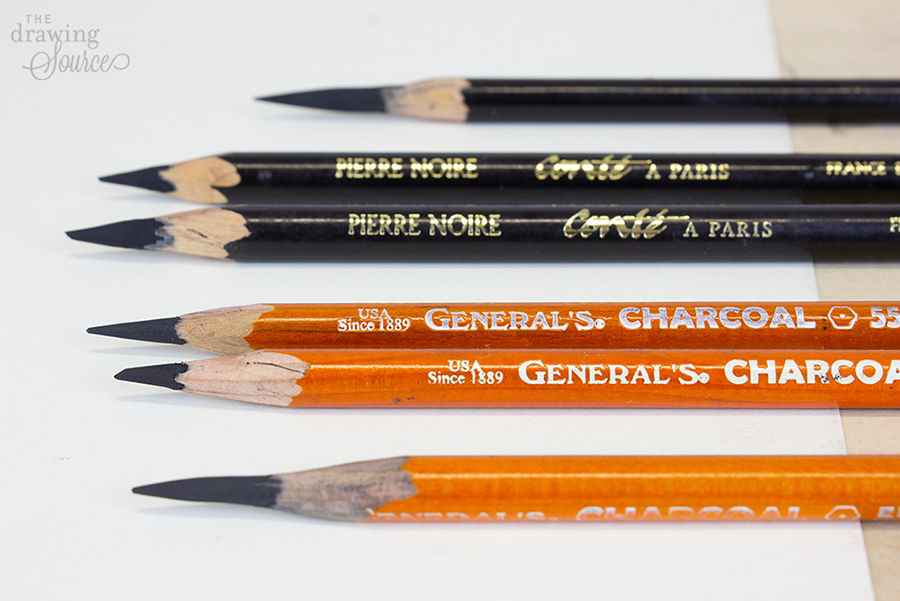 General's Charcoal Pencils vs Conte Pierre Noire 1710 Pencils
General's Charcoal Pencils vs Conte Pierre Noire 1710 Pencils
I recently compared Generals Charcoal Pencils with Conte
Pierre Noire 1710 Pencils, for a student who did not have access to the
General’s pencils (which I usually recommend).
Because the Conte brand makes another set of pencils specifically called ‘Charcoal’, not ‘Pierre Noire’, I assume that the Pierre Noire pencils are some sort of proprietary mixture (not pure charcoal). After working with them and comparing them to Generals charcoal pencils, I conclude that the characteristics of Conte Pierre Noire Pencils convincingly resemble charcoal. The main difference, as I mention earlier on this page, is that they are slightly waxier, which makes them less powdery and less messy, but also less blendable.
How I came to these conclusions:
Comparing Charcoal Pencil Brands
Test 1: Quick gradations to discover the pencils' 'natural range'
I start my comparison by drawing some very quick, casual
gradations (shown below). These are not particularly smooth, and are drawn in
the value range that is easiest to achieve with each pencil (meaning that it is
certainly possible to draw darker values with each pencil, it would simply
require more layers and/or pressure). I’m looking to discover the natural or most comfortable range of
each pencil.
As you can see, I placed the Conte Pierre Noire HB gradation
next to the General’s Charcoal HB gradation, the CPN 2B next to the Gen 2B, and
vice versa, so that I could compare the grades.
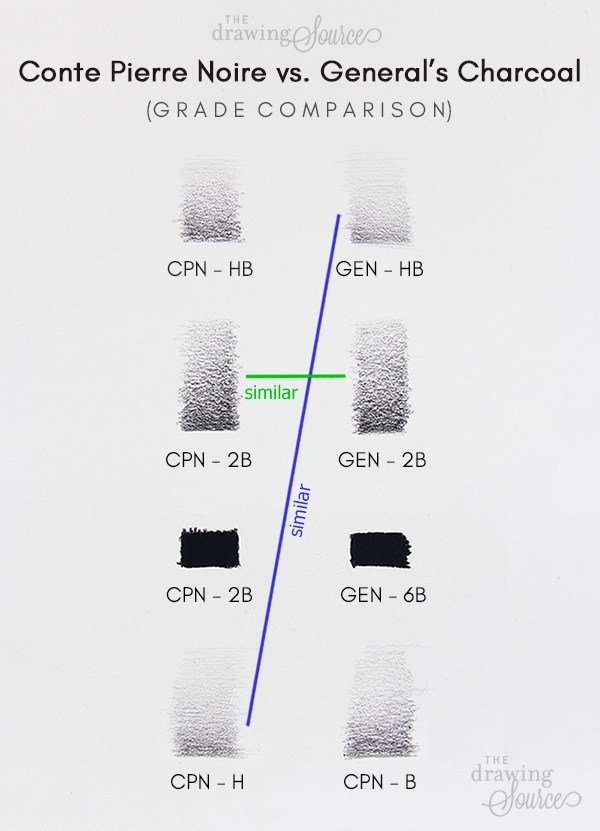 Comparison of General's Charcoal Pencils and Conte Pierre Noire 1710 Pencils
Comparison of General's Charcoal Pencils and Conte Pierre Noire 1710 Pencils
The Results
Comfort and Ease of Use: The Conte Pierre Noire pencils are slightly thicker than General's. This adds some time and effort to the pencil sharpening process, and makes it slightly more difficult to sharpen a Conte Pierre Noire pencil to a sharp point. Their thickness makes them slightly heavier than the General's pencils as well, which took me a few minutes to get used to.
Smoothness of Application: During my first test I found General's to be slightly smoother, but during my second test I thought the Conte Pierre Noire pencils felt slightly smoother. So I'll call it even! Of course, how smoothly charcoal can be applied depends on what kind of paper you are using as well. I am testing on Strathmore 400 Drawing Paper, as well as Strathmore Bristol Paper (both smooth drawing papers).
Range of Pencils: After conducting my tests I discovered that I have two sets of Conte Pierre Noire 1710 pencils (shown below). I used the gold set, which contained an H, HB, B and 2B pencil. This meets my 'range of at least 4 pencils' criteria.
Remember that I look for a pencil that can easily create a pitch black value, a pencil with which to draw the lightest possible values, and a few in between those two extremes. If you look at the image above, you'll notice that:
- The 2B Conte Pierre Noire pencil darkened to a pitch black (though it did take more effort and layering to do so than the 6B Generals pencil).
- The H Conte Pierre Noire pencil allowed me to draw a gradation from the white of the paper into a light value (this was fairly easy, just as easy as the General's HB pencil).
- I noticed that the 2B pencils of both brands had a similar range, but the Conte Pierre Noire H pencil range was comparable to the General's HB charcoal pencil range. This is just an observation - it's normal for the ranges of two brands to differ slightly. As long you have a full range of values within each brand, it passes the test!
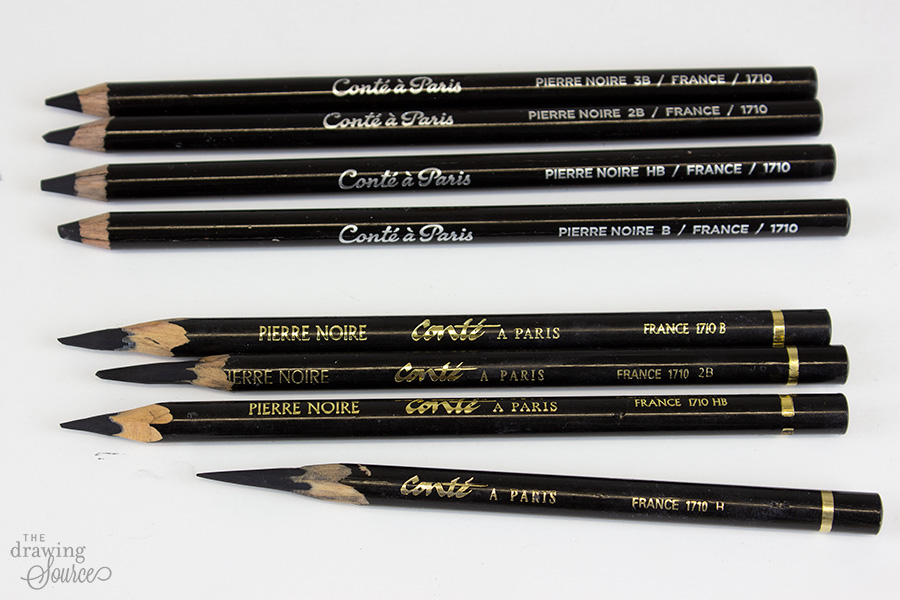
Comparing Charcoal Pencil Brands
Test 2: Erasability
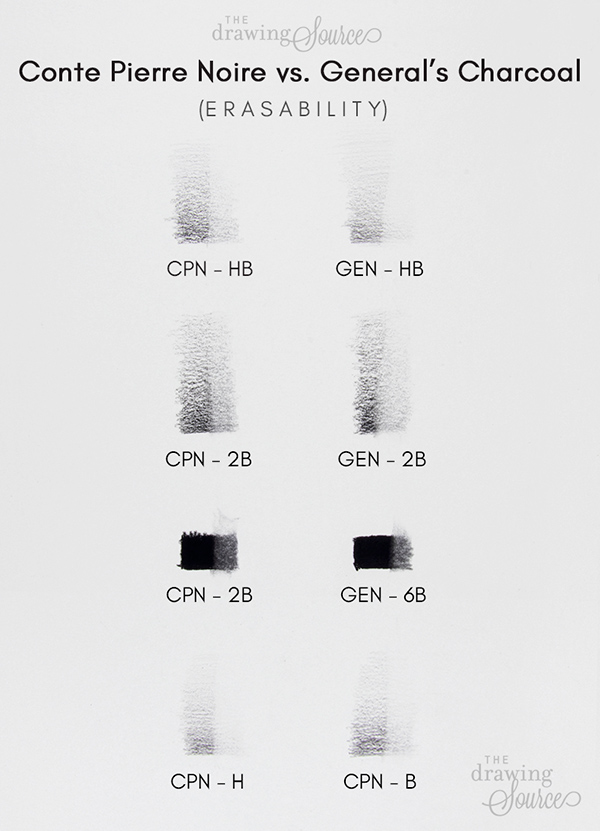
Erasability Results: The erasability of both brands is very similar, especially when keeping in mind that the Conte Pierre Noire H pencil is similar to the General's Charcoal HB pencil. (Speaking of erasability, don't miss my video tutorial on 3 ways to use a kneaded eraser for realistic drawing.)
Comparing Charcoal Pencil Brands
Test 3: Smooth, manual gradation (no blending tools)
My initial tests above were very quick and gave me an overall impression of the pencils I was comparing. To take the charcoal pencil brand comparison a step further, I recommend drawing a smooth gradation manually (meaning without the use of blending tools), using pencils that have a similar range. In the gradations below, I compared an HB Generals Charcoal Pencil and an H Conte Pierre Noire Pencil, because my earlier tests revealed that their ranges are similar.
Learn how I stabilize my hand to have the most stability and control of my pencil to draw the gradations below in this video tutorial.
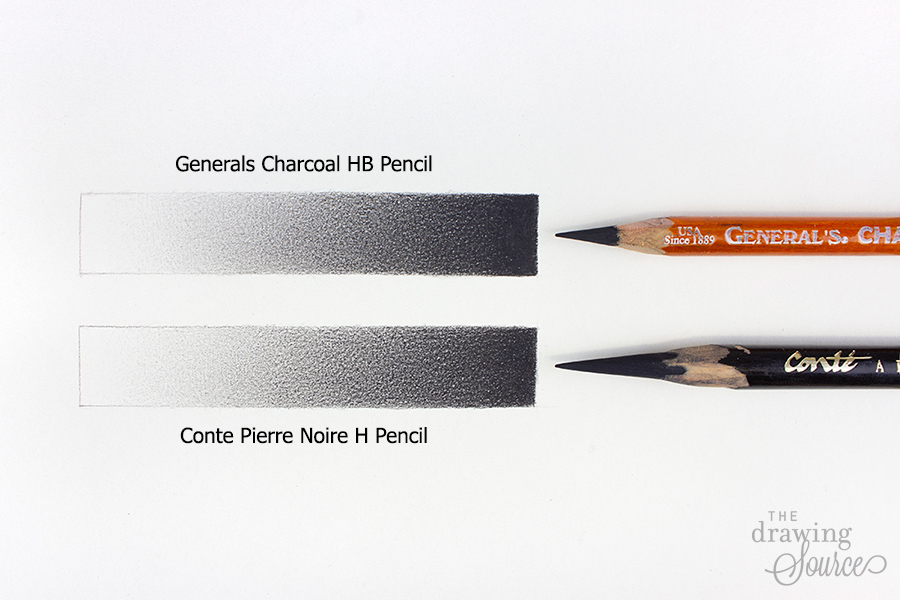
The Results
My impressions from my initial tests are holding up. I notice that the Conte Pierre Noire H pencil has a slightly lighter range than the General's Charcoal HB pencil. This made it easier to draw the lighter values of my gradation, and to gradate them almost imperceptibly from the white of the paper. This could be a benefit to beginners just starting to work with charcoal!
I'm enjoying working with the Conte Pierre Noire pencils and am noticing that they are slightly less powdery than the General's Charcoal pencils. This makes them slightly cleaner to work with, which is enjoyable (and could also be a benefit to beginners), but I'm curious how this will affect their blendability in the next test.
So far I have evaluated the five criteria that I consider to be essential, and I'm finding these brands to be slightly different, but equally excellent. Let's move on to the additional criteria:
Comparing Charcoal Pencil Brands
Test 4: How well do these charcoal pencil brands blend?
To test blendability, I draw a small square of dark value using a 2B Generals Charcoal pencil and a 2B Conte Pierre Noire pencil. I compare softer pencils in this test because I tend to use blending tools primarily on darker values.
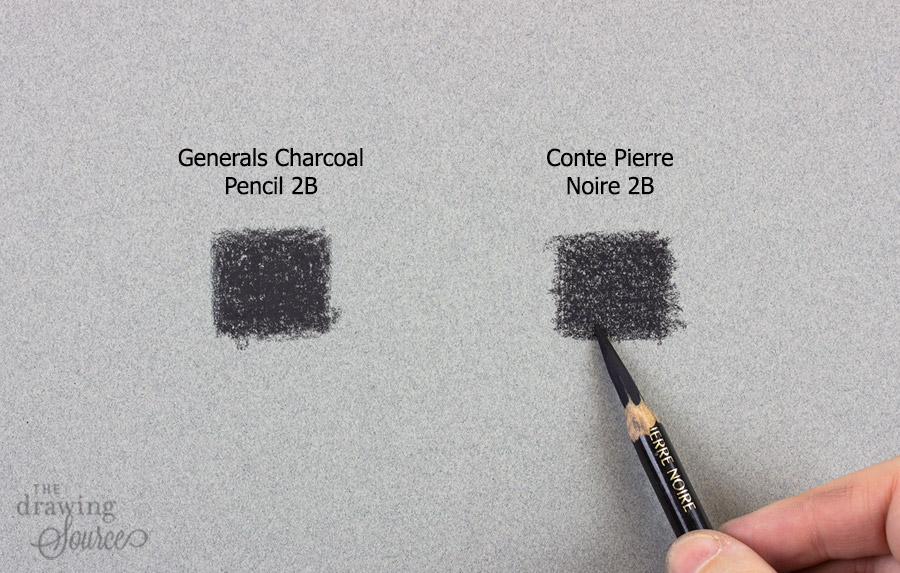
The blending tool that I use most often is an inexpensive paintbrush, so that is what I use to blend the values below:
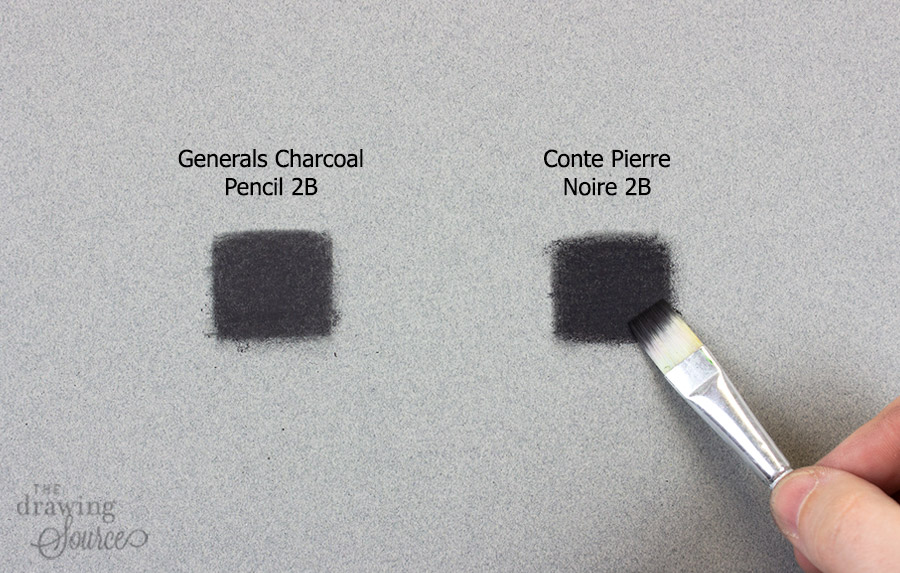
Results: How well did these charcoal pencil brands blend
The 2B General's pencil is more powdery and blended with less effort. However, the 2B Conte Pierre Noire pencil didn't lighten as much as the General's pencil (brushing over a drawn area always lightens its value). This results in a similar-looking effect. The blendability is ultimately more similar than I expected.
Comparing Charcoal Pencil Brands
Test 5: Combining Charcoal with a White Drawing Pencil
My favorite white pencil to use with charcoal is the General's Charcoal White 558 Pencil. However, Conte a Paris makes a white pencil as well. Curious to try it, and thinking that it might blend better with pencils of its own brand, I combined the General's Charcoal with the General's White 558 Pencil, and the Conte Pierre Noire with the Conte White 630 Pencil.
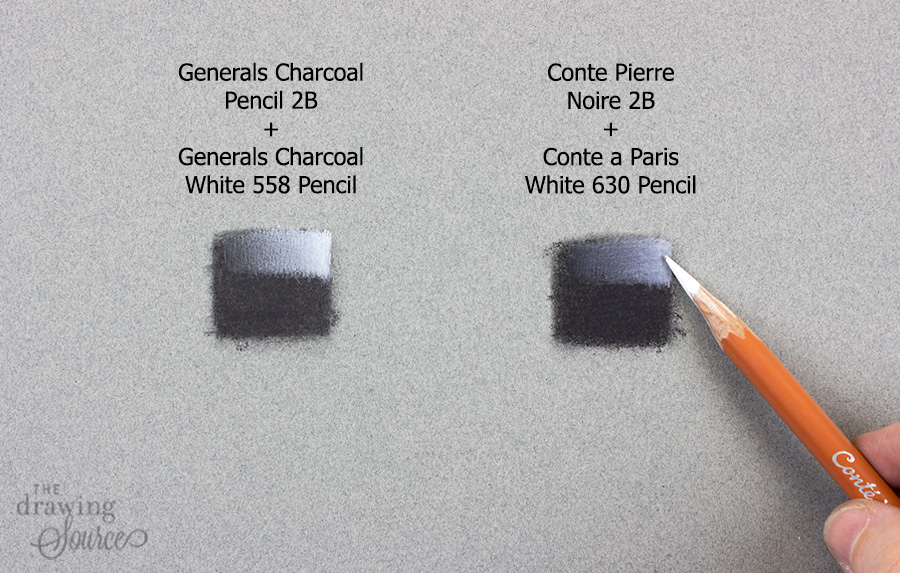
Results:
The General's White Pencil is much brighter and less blue than the Conte white pencil. It layered overtop of the General's charcoal more smoothly than the Conte, likely due to General's charcoal being more powdery than the Conte Pierre Noire pencils.
Out of curiosity, I repeated this experiment, this time using the General's White Pencil over the 2B Conte Pierre Noire value square. The results were essentially the same.
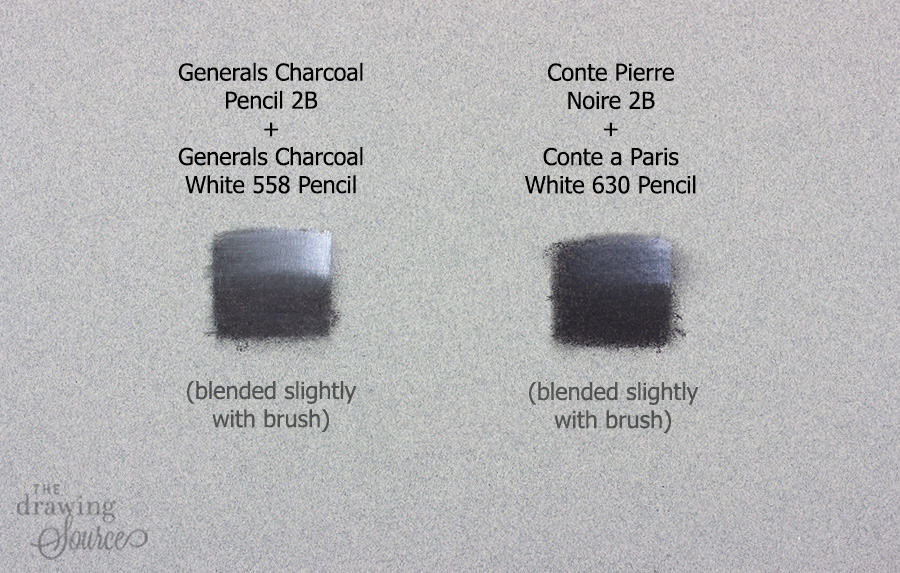
The above image was taken after lightly blending the value squares with a paintbrush. As you can see, due to its powdery nature, the General's charcoal and white pencil combination blended together much more smoothly and evenly, and remained brighter overall.
Conclusions
After conducting these experiments, I am confident that both of these charcoal pencil brands are excellent.
I would recommend the Conte Pierre Noire pencils to beginners looking to use charcoal for the first time, or to those who have started using charcoal and are feeling intimidated. The Conte Pierre Noire pencils are less powdery, less messy and slightly easier to control than pure compressed charcoal, while still providing the best qualities of charcoal.
I would recommend General's Charcoal Pencils for anyone looking to blend charcoal with white (read about the technique on this page), for those who want to cover a large surface area with very dark value (because the more blendable General's 4B or 6B would be most convenient), or generally to those with some experience using charcoal pencils.
Stay tuned for further comparisons of charcoal pencil brands, and certainly reach out to me with any questions!
Happy Drawing,
Enjoyed this page? Please share it!
Share buttons and pinnable images below:
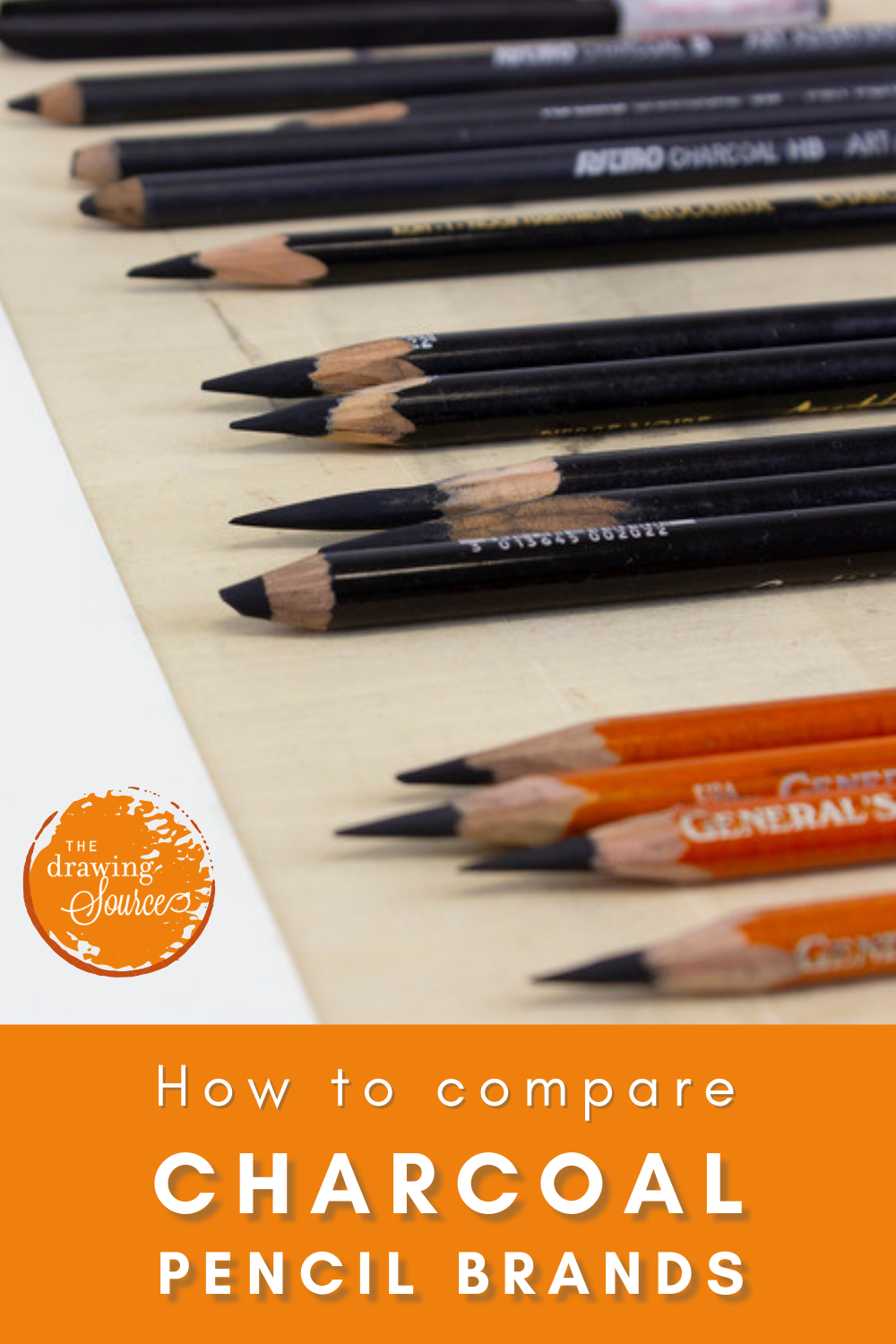

If you enjoyed this page, you might also be interested in:
Related Pages
How to Sharpen a Drawing Pencil (Video Tutorial)
How to Hold and Control a Drawing Pencil (Video Tutorial)
3 Ways to Use White Charcoal Pencils
3 Ways to Use a Kneaded Eraser for Realistic Drawing (Video Tutorial)
Return to Drawing Supplies from How to Compare Charcoal Pencil Brands
Return to the Homepage from How to Compare Charcoal Pencil Brands



